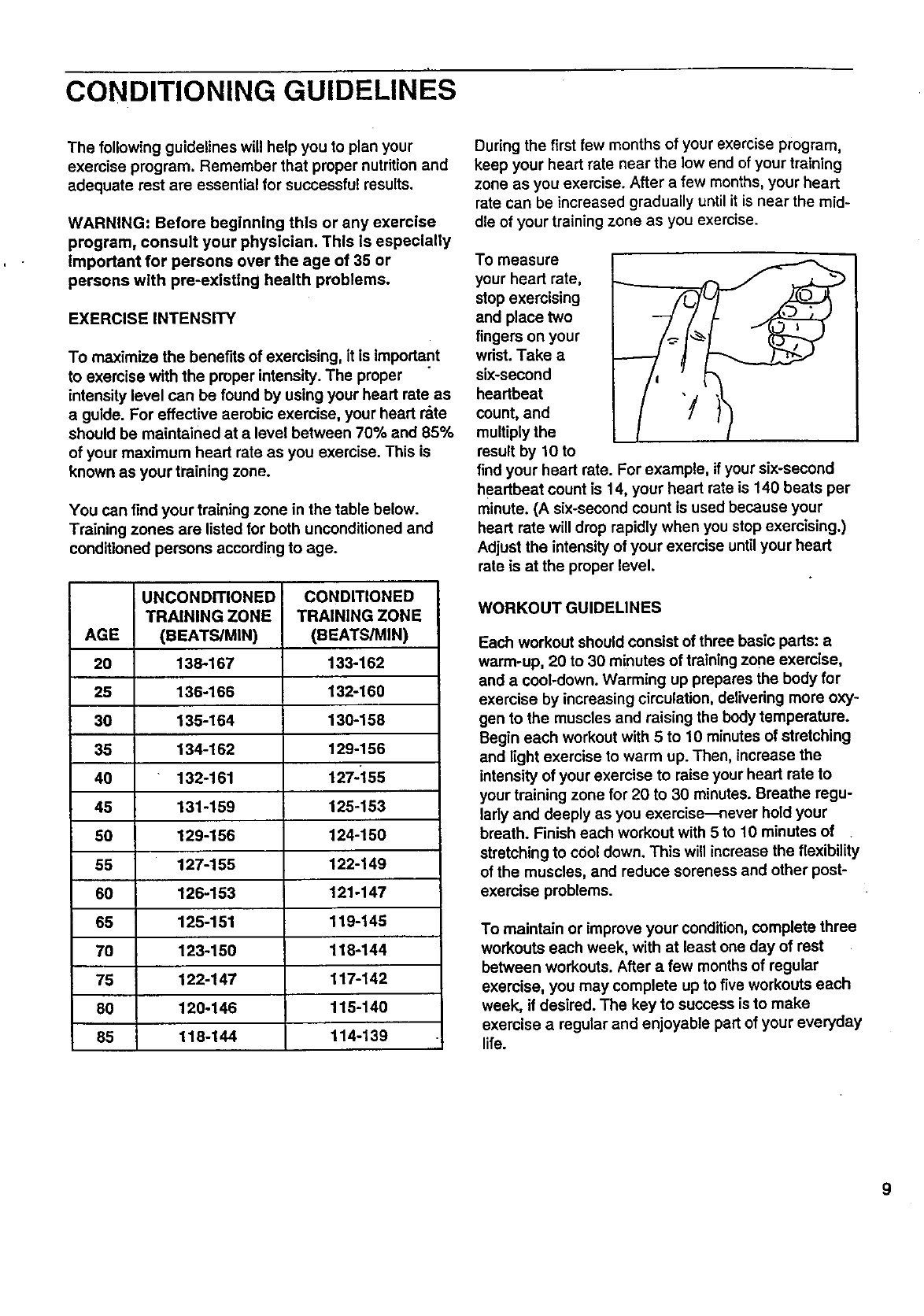
CONDITIONING GUIDELINES
The following guidelines willhelp you to plan your
exercise program. Remember that proper nutrition and
adequate rest are essential for successful results.
WARNING" Before beginning this or any exercise
program, consult your physician. This Is especially
important for persons over the age of 35 or
persons with pre-exlsttng health problems.
EXERCISEINTENSITY
To maximize the benefits of exercising, it is important
to exercise with the proper intensity. The proper
intensity level can be found by using your heart rate as
a guide. For effective aerobic exercise, your heart rate
should be maintained at a level between 70% and 85%
of your maximum heart rate as you exercise. This is
known as your training zone.
You can find your training zone in the table below.
Training zones are listedfor both unconditioned and
conditioned persons according to age.
UNCONDITIONED CONDITIONED
TRAINING ZONE TRAINING ZONE
AGE (BEATS/MIN) (BEATS/MIN)
20 138-167 133-162
25 136-166 132-160
30 135-164 130-158
35 134-162 129-156
40 132-161 127-_155
45 131-159 125-153
50 129-156 124-150
55 127-155 122-149
60 126-153 121-147
65 125-151 119-145
70 123-150 118-144
75 122-147 117-142
80 120-146 115-140
85 118-144 114-139
During the first few months of your exercise program,
keep your heart rate near the low end of your training
zone as you exercise. After a few months, your heart
rate can be increased gradually until it is near the mid-
dle of your training zone as you exercise.
To measure
your heart rate,
stop exercising
and place two
fingers on your
wrist.Take a
six-second
heartbeat
count, and
multiplythe
result by 10 to
findyour heart rate. For example, ifyour six-second
heartbeat count is 14, your heart rate is 140 beats per
minute. (A six-second count is used because your
head rate will drop rapidly when you stop exercising.)
Adjust the intensity of your exercise until your heart
rate is at the proper level.
WORKOUT GUIDELINES
Each workout should consist of three basic pads: a
warm-up, 20 to 30 minutes of trainingzone exemise,
and a cool-down. Warming up preparesthe body for
exercise by increasing circulation, delivering more oxy-
gen to the muscles and raising the bodytemperature.
Begin each workout with 5 to 10 minutes ofstretching
and light exercise to warm up. Then, increase the
intensity of your exercise to raise your head rate to
your training zone for 20 to 30 minutes. Breathe regu-
larly and deeply as you exercise-never hold your
breath. Finish each workout with 5 to 10 minutes of
stretching to cool down. This will increase the flexibility
of the muscles, and reduce soreness and other post-
exercise problems.
To maintain or improve your condition,complete three
workouts each week, with at least one day of rest
between workouts. After a few monthsof regular
exercise, you may complete up tofive workouts each
week, if desired. The key to success isto make
exercise a regular and enjoyable part of your everyday
life.
9














